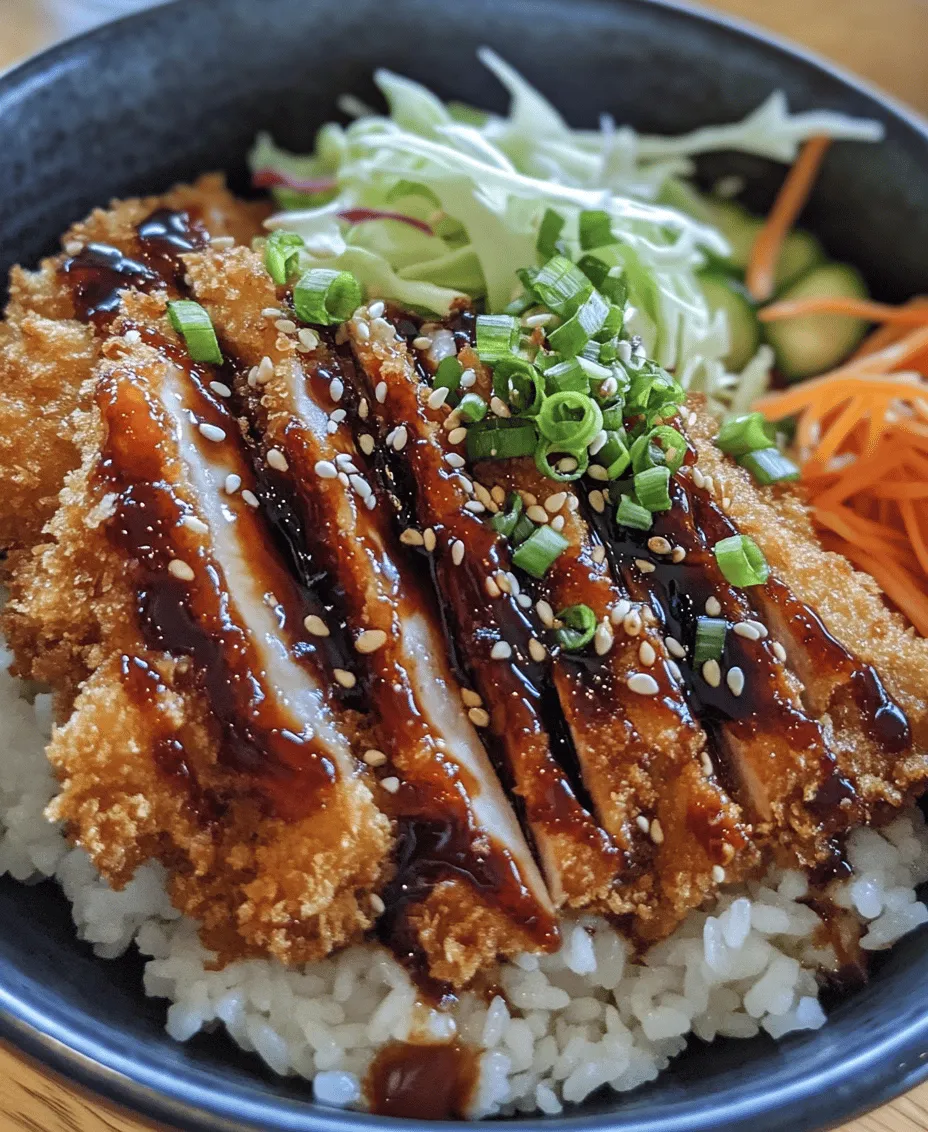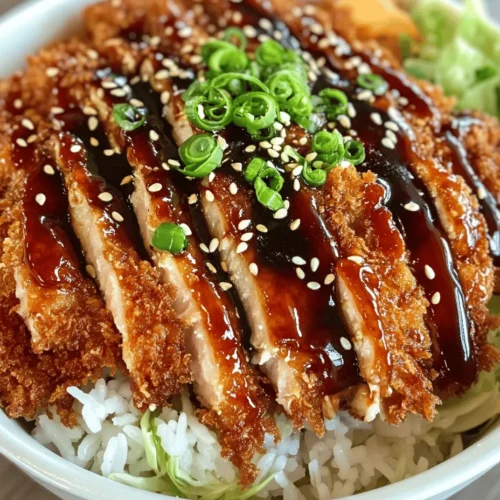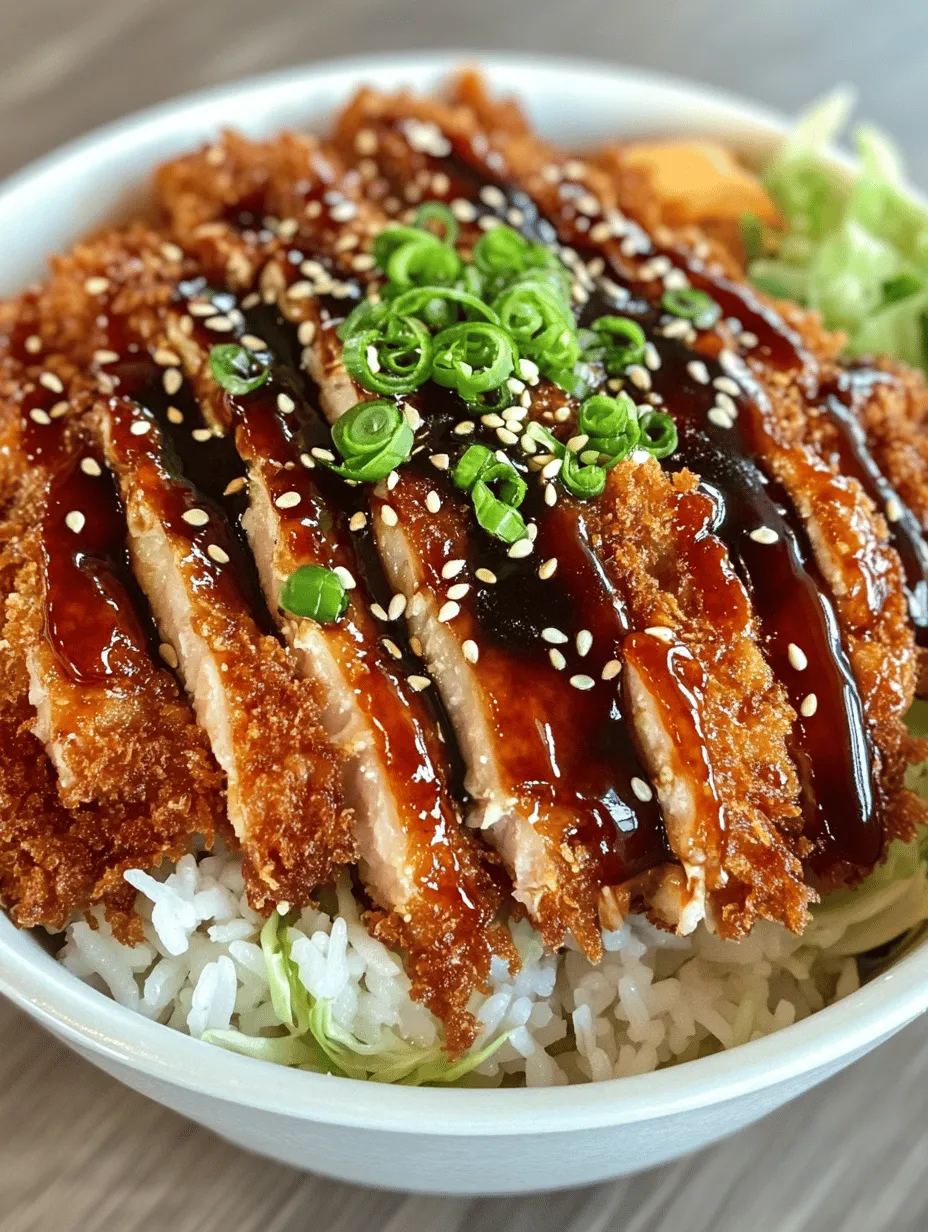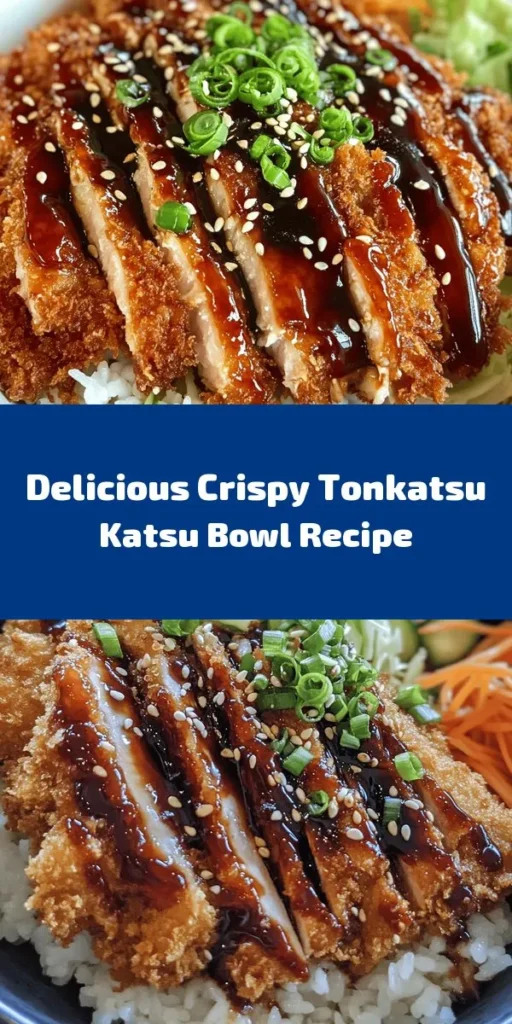Introduction
If you’re on the lookout for a dish that embodies comfort, flavor, and a touch of culinary tradition, look no further than Crispy Tonkatsu Katsu Bowls. This Japanese delicacy combines the satisfying crunch of deep-fried pork with the fluffy goodness of rice, making it a favorite among food lovers around the globe. With its origins deeply rooted in the heart of Japan, Tonkatsu has evolved into a staple dish that graces countless dining tables, celebrated not only for its taste but also for its easy preparation.
In this article, we will take a closer look at the components that make up Tonkatsu, explore the preparation process, and understand the cultural significance of this dish. From the selection of the right cut of pork to the ideal balance of flavors in the Tonkatsu sauce, we will guide you through each step needed to create your own delightful Katsu Bowl at home.
Understanding Tonkatsu: The Heart of the Dish
Definition and Origins of Tonkatsu
Tonkatsu, which translates to “pork cutlet” in Japanese, is a dish that features a breaded and deep-fried pork loin or tenderloin. Its history traces back to the Meiji era (1868-1912), when Western cuisine began to influence Japanese cooking. The introduction of breaded meat dishes, such as the European cutlet, inspired Japanese chefs to create their own version, leading to the birth of Tonkatsu. Today, it is a beloved dish not just in Japan but also in various countries, where it has been embraced and adapted to suit local palates.
The Role of Tonkatsu in Japanese Cuisine
In Japanese cuisine, Tonkatsu is more than just a meal; it represents a fusion of flavors and techniques that highlight the sophistication of Japanese culinary arts. It is typically served with shredded cabbage, a bowl of rice, and a drizzle of savory Tonkatsu sauce, making it a well-rounded dish that appeals to a wide range of tastes. Tonkatsu is often enjoyed as a comforting meal after a long day, making it a popular choice for both families and individuals alike.
Nutritional Benefits of Tonkatsu
While Tonkatsu is indulgent in nature, it also provides nutritional benefits. Pork loin is a good source of protein, essential for muscle growth and repair. The dish can be paired with fresh vegetables like cabbage, which adds fiber and nutrients, enhancing the overall healthiness of the meal. By opting for lean cuts of pork and controlling the frying process, you can enjoy this flavorful dish without compromising on nutrition.
Ingredients: A Closer Look at What You Need
To prepare a delicious Crispy Tonkatsu Katsu Bowl, understanding the ingredients is key. Each component plays a vital role in bringing out the flavors and textures that make this dish so appealing.
Breakdown of Tonkatsu Ingredients
1. Pork Loin Chops: The star ingredient of the dish, pork loin provides the perfect balance of tenderness and flavor. It’s crucial to select high-quality pork to ensure a juicy and succulent cutlet.
2. Seasoning: Simple yet effective, salt and pepper are essential for enhancing the natural flavor of the pork. They should be applied generously before breading the meat.
3. Breading Process: The classic Tonkatsu breading involves a three-step process: coating the pork in flour, dipping it in beaten egg, and finally rolling it in panko breadcrumbs. Panko, known for its light and crispy texture, is what gives Tonkatsu its signature crunch.
4. Tonkatsu Sauce Components: This sauce is a blend of sweetness and umami, typically made from ingredients such as Worcestershire sauce, soy sauce, ketchup, and sugar. The balance of flavors in the sauce is crucial for complementing the rich flavors of the pork.
5. Balancing Sweetness and Umami: The ideal Tonkatsu sauce strikes a balance between sweet and savory, enhancing the overall taste of the dish. Experimenting with the proportions can help you find the perfect blend that suits your palate.
6. Customizing Sauce to Personal Taste: Feel free to add unique elements such as garlic powder, mustard, or even a splash of sake to tailor the sauce to your liking.
Essential Ingredients for Katsu Bowls
Beyond the Tonkatsu itself, a complete Katsu Bowl includes additional ingredients that round out the meal.
1. Japanese Short-Grain Rice: The foundation of any Katsu Bowl, short-grain rice is sticky and fluffy, making it the perfect base to soak up the flavors of the Tonkatsu and sauce.
2. Fresh Vegetables: Shredded cabbage and sliced green onions are traditional accompaniments that add freshness and crunch to the dish. They provide a contrast to the rich and savory elements of the bowl.
3. Optional Garnishes: To elevate your Katsu Bowl, consider adding sesame seeds for a nutty flavor or pickled ginger for a zesty kick. These garnishes enhance both the presentation and taste of the dish.
Preparation Process: Step-by-Step Guide to Making Tonkatsu Katsu Bowls
Creating a Crispy Tonkatsu Katsu Bowl at home involves several key steps. Each step is designed to maximize flavor and ensure the perfect texture for your Tonkatsu.
Preparing the Tonkatsu Sauce: A Flavorful Foundation
1. Mixing Techniques for Optimal Flavor: Begin by combining the various sauce ingredients in a bowl. Use a whisk to blend them thoroughly until you achieve a smooth consistency. Taste the sauce and adjust the ingredients as needed to achieve your desired balance of sweetness and umami.
2. Letting the Sauce Rest: Allow the sauce to sit for at least 15-20 minutes before serving. This resting period lets the flavors meld together, resulting in a richer taste.
Preparing the Pork: Techniques for Tenderness
1. Choosing the Right Cut: Select boneless pork loin chops that are about 1-inch thick. This thickness ensures that the meat remains juicy during the frying process.
2. The Importance of Pounding the Meat: To ensure even cooking and tenderness, pound the pork chops to about 1/2 inch thick using a meat mallet or rolling pin. This technique breaks down the fibers in the meat, leading to a more tender bite.
3. Seasoning the Pork: Generously season both sides of the pork with salt and pepper. This step enhances the flavor profile and ensures that every bite is seasoned perfectly.
In the following parts of this article, we will continue to explore the remaining steps in the preparation of Crispy Tonkatsu Katsu Bowls, including the breading and frying process, as well as tips for serving and enjoying this delightful dish. Stay tuned for a culinary journey that will leave your taste buds craving more!

Breading the Pork: Achieving Perfect Crispiness
To create that signature crunchy exterior of tonkatsu, proper breading technique is essential. Achieving perfect crispiness can elevate the dish and ensure that each bite is satisfying.
Setting Up the Breading Station
A well-organized breading station is key to achieving an even and crispy coating. Here’s how to set it up effectively:
1. Ingredients Preparation: Gather your ingredients: all-purpose flour, eggs, and panko breadcrumbs. Consider having a shallow dish for each ingredient.
2. Breading Process: Arrange the dishes in the following order: flour first, followed by beaten eggs, and then panko breadcrumbs. This sequence allows for a smooth transition from dry to wet to dry, ensuring a good grip for the breadcrumbs.
3. Tools: Use one hand for the dry ingredients and the other for the wet to avoid clumping. This technique will keep your hands cleaner and the process more efficient.
Tips for Even Coating
To achieve an even coating on your pork cutlet, follow these tips:
– Pat the Meat Dry: Before breading, ensure that your pork cutlet is dry. This helps the coating stick better. Use paper towels to remove excess moisture.
– Flour First: Lightly coat the pork in flour, shaking off any excess. The flour helps the egg adhere to the meat.
– Egg Wash: Dip the floured cutlet into the beaten eggs, ensuring it’s evenly covered. Allow any excess egg to drip off.
– Panko Breadcrumbs: Finally, coat the cutlet in panko breadcrumbs. Press them gently to ensure they stick well.
Frying the Tonkatsu: Achieving Golden Perfection
Now that your pork is breaded, it’s time to fry it to perfection. The frying process is crucial for achieving that golden-brown exterior while keeping the meat juicy inside.
Oil Temperature and Cooking Time Guidelines
– Heat the Oil: In a deep frying pan or skillet, heat vegetable oil to about 350°F (175°C). A thermometer can help you monitor the temperature accurately.
– Frying Time: Fry each cutlet for about 3-4 minutes per side, depending on thickness. The goal is to achieve a golden brown color on both sides.
– Batch Cooking: Avoid overcrowding the pan; fry in batches if necessary. Overcrowding can cause the oil temperature to drop, resulting in soggy cutlets.
Ensuring Proper Cooking Temperature for Safety
To ensure that your tonkatsu is safe to eat, it’s essential to check the internal temperature. Use a meat thermometer; the pork should reach an internal temperature of 145°F (63°C) for safe consumption.
Assembling the Katsu Bowls: Presentation Matters
Once your tonkatsu is perfectly fried, it’s time to assemble the katsu bowls. Presentation plays a significant role in enhancing the dining experience.
Layering Ingredients for Visual Appeal
1. Rice Base: Start with a generous serving of steamed white rice at the bottom of each bowl. The rice serves as a neutral base that complements the tonkatsu.
2. Cut the Tonkatsu: Slice the fried tonkatsu into strips for easier eating and an appealing presentation. Arrange the cutlets artfully on top of the rice.
3. Vegetables: Add a side of shredded cabbage or pickled vegetables for a crunch and a pop of color. The freshness contrasts beautifully with the richness of the tonkatsu.
Drizzling Sauce and Adding Garnishes
– Tonkatsu Sauce: Drizzle tonkatsu sauce over the cutlets. This thick, sweet-sour sauce enhances the flavors and adds an extra layer of richness.
– Garnishes: Finish with a sprinkle of sesame seeds and finely chopped green onions. These not only add flavor but also elevate the visual appeal of the dish.
Cultural Significance of Tonkatsu Katsu Bowls
Tonkatsu is more than just a dish; it holds a special place in Japanese culture and cuisine.
Tonkatsu in Japanese Gastronomy
Originating in the late 19th century, tonkatsu was inspired by European cooking methods, particularly the schnitzel. It quickly became integrated into Japanese cuisine, evolving from a foreign concept into a beloved national dish.
Historical Context and Evolution
Initially enjoyed by the upper class, tonkatsu has transformed into a comfort food found in homes and restaurants across Japan. Over the years, different variations and interpretations have emerged, showcasing regional influences and personal touches.
The Dish as a Comfort Food
Tonkatsu embodies the essence of comfort food in Japan. It’s often associated with home-cooked meals and family gatherings, making it a staple in many households. The crunch and savory flavor provide a sense of warmth and satisfaction.
Celebrating Family and Gatherings
Tonkatsu is frequently served during celebrations and special occasions, symbolizing joy and togetherness. Sharing katsu bowls with loved ones fosters a sense of community and connection.
Variations of Tonkatsu Around the World
As tonkatsu has gained popularity beyond Japan, various adaptations have emerged. In other countries, you may find different meats used, such as chicken or even vegetarian options, showcasing the versatility of this beloved dish.
Serving Suggestions and Pairings
To enhance your tonkatsu katsu bowls, consider these serving suggestions and pairings:
Ideal Accompaniments for Tonkatsu Katsu Bowls
– Miso Soup: A warm bowl of miso soup provides a comforting side dish that pairs beautifully with the flavors of tonkatsu.
– Japanese Pickles: Tsukemono, or Japanese pickles, add a refreshing crunch and balance the richness of the fried cutlet.
Beverage Pairings: Sake, Beer, and Tea
– Sake: A chilled bottle of sake complements the flavors of tonkatsu and elevates the dining experience.
– Japanese Beer: Light, crisp beers such as Asahi or Sapporo are also excellent choices that enhance the meal.
– Green Tea: For a non-alcoholic option, serve warm green tea to cleanse the palate between bites.
Creative Twists on Traditional Katsu Bowls
– Vegetarian and Vegan Alternatives: Consider using eggplant or tofu coated in panko for a vegetarian take on tonkatsu. These alternatives still provide a satisfying crunch and flavor.
– Flavor Enhancements with Different Sauces: Experiment with different sauces such as spicy mayo or garlic aioli for a unique twist on the traditional tonkatsu sauce.
Conclusion
Crispy tonkatsu katsu bowls offer a delightful blend of textures and flavors that can elevate any meal. This dish not only provides a satisfying dining experience but also connects us to the rich culinary heritage of Japan. By understanding the preparation steps and the cultural significance behind tonkatsu, you can appreciate this dish even more. Enjoy crafting your own katsu bowls and sharing them with family and friends, making every meal a celebration of taste and tradition. Whether you’re indulging in the classic recipe or exploring creative variations, tonkatsu katsu bowls are sure to delight your taste buds and bring joy to your dining table.



